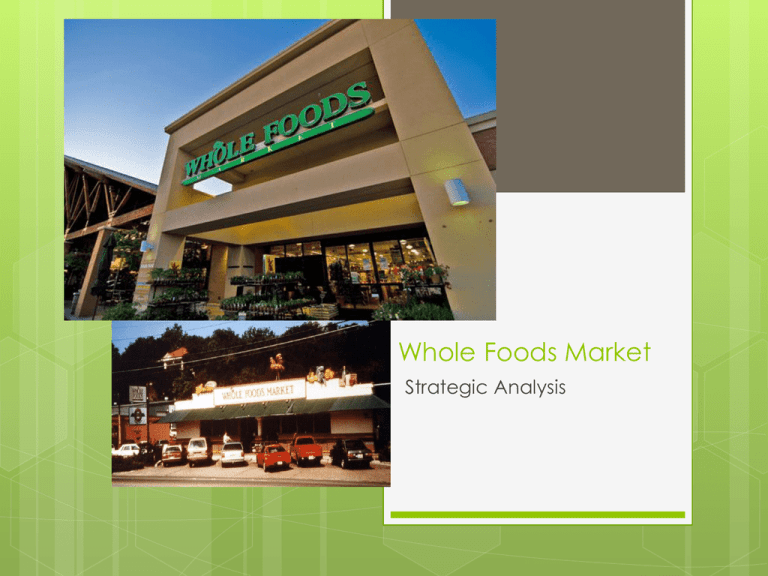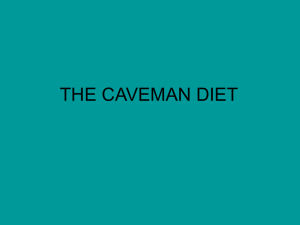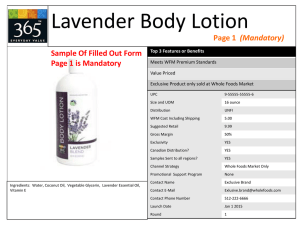Whole Foods Market
advertisement

Whole Foods Market Strategic Analysis Company Introduction Whole Foods Market (WFM) is a supermarket that specializes in natural and organic goods. It is one of the largest natural food stores in the world. As of September 2013 it has a total of 362 stores and over one hundred in development. Stores in 40 US states, Canada and the United Kingdom. Attracts customers wanting to live a healthier lifestyle and are environmentally conscience. Whole Foods Market Mission Whole Foods aims to help support the health, well-being, and healing of people, customers, Team Members, business organizations, as well as the planet. Intends on providing the best quality in organic and natural foods to satisfy, delight and nourish its customers. Whole Foods Market Declaration “ Whole Foods Market is a dynamic leader in the quality food business and is a mission driven company that aims to set the standards of excellence for food retailers. We are building a business in which high standards permeate all aspects of our company. Quality is a state of mind at Whole Foods Market.” Whole Foods Market Core Values Sell the highest quality natural and organic products available Satisfy, Delight and Nourish customers Support Team Members happiness and excellence Open and timely information Create wealth trough profits and growth Serve and Support our local and global communities Practice and Advance environmental stewardship Whole Foods Market Background 1978-started by John Mackey and Rene Lawson in Austin, TX as SaferWay 1980-partnered with Craig Weller and Mark Skiles to merge their Natural Grocery to create the First Whole Foods Market. 1984-expanded outside of Ausitn, TX 2000s- expanded outside of the United States Craig Weller, Renee Lawson Hardy, John Mackey Whole Foods Market Dedication Highest quality food at competitive prices Food is evaluated by nutrition, freshness, appearance and taste. Food Safety Purchase products locally, to provide the freshest products available and reduces the environmental impact of transporting products Boost local economies Products Fresh Produce: Fruits and Vegetables Organic and Natural Meats, Poultry, and Seafood Daily baked bread and pastries Prepared goods Salad Bars and Sandwich Stations Cheeses and Frozen Foods Beer and Wines Coffees and Teas Grocery and Household products Body Care and Nutritional items Pet products Educational Materials Private Label items at lower costs Strategy SWOT Analysis Broad framework of analysis Allows for the evaluation of the internal and external environment of a firm Explains Whole Foods Market’s Strengths Weaknesses Opportunities Threats Strengths Broad Product Offering and Rapid Distribution. WFM has a product selection with a strong emphasis on perishable foods designed to appeal to a diverse customer base that includes individuals interested in both natural and organic foods as well as customers interested in fresh gourmet items. Strengths Focused Growth Strategy WFM management focuses on expansion Opening of new stores in new and existing trade areas Managements strategy to grow through identical store sales growth, acquisition and new store openings has enabled WFM to grow at a compounded annual growth rate of 27% since 1991 Strengths Revenue Growth WFM’s food strategy is well suited for the market conditions prevalent in the industries. Rapid growth in sales for natural and organic foods returned about $30 to $35 billion in revenue for 2009 In 2011 the company reported net revenue of $10.1 billion, representing 11.22% annual growth per year Analysts anticipate a continuation of growth and estimate 2016 revenues to yield $20 billion. Weaknesses Product Recalls Contamination Recalls including recalls on items from the private label brand Negatively affect the brand image and customer confidence Leads to low customer loyalty and brand equity Weaknesses International Operations Operates only eight stores in Canada Operates only seven stores in the United Kingdom Operation are not large enough internationally to reach economies of scale in purchasing and logistics. Inability to yield economies of scale stimulated the need for an increase in product pricing Competition has a competitive advantage with the more efficient network structure that allows for a decrease in product pricing 95% of WFM stores are located within the United states. Existing portfolio distribution makes WFM highly sensitive to the US economic market Weaknesses • Rental Agreements • • • • Many Obligations under certain capital leases for facilities and equipment Capital leases are subject to the laws and therefore directly effect the company’s financial position Increasing rental expenses affect the company’s profitability Rental Expenses for: • • • 2010-303.5 million 2009- 281.9 million 2008- 257.5 million Weaknesses Pricing A major Weakness to WFM is that in general, individuals view organic food as high priced. Weak distribution network in Canada and the UK are barriers to WFM’s ability to achieve economies of scale. To effectively compete with other stores, WFM must invest heavily in logistic abroad and brand image in the US Opportunities Changing Market Conditions Increase in amount of people interested in natural and organic foods as part of a healthy lifestyle Global sales of organic products grows every year Present opportunities for development and expansion in the area of natural and organic foods in mainstream customer markets Opportunities Political Interest and Regulation New USDA standards for labeling organic food products sold in grocery Presents an opportunity for WFM to promote the merits of organically grown products to consumers Political and celebrity interest also presents a significant opportunity to WFM Threats Regulation Natural and organic food markets are subject to laws and regulations relating to health, sanitation and food labeling. Critical Standards are in place for the manufacture, processing , formulation, packaging, labeling and advertising of products. Failure to comply results in penalties, seizure of marketing and sales licenses, and additional compliance costs. Threats Competition Food retailing is a large intensely competitive industry Competes with local, regional, national, conventional and specialty supermarkets, natural food stores, warehouse membership clubs, smaller specially stores, farmers’ markets and restaurants. Competition stores carry similar products, meaning loss of sales and profits are highly dependent on price and quality of products, as well as customer loyalty. Threats Competition Top 3 competitors for WFM are Walmart, Safeway, and Kroger Many other supermarkets are beginning to enter into the organic market and offering healthy alternatives to mainstream customers. Whole Foods Strategies Marketing Strategy Expansion Strategy Merchandising Strategy Pricing Strategy Financial Strategy Marketing Strategy Spends very little on advertising Advertising fee is only .5% of revenues Relies on Word-of –Mouth recommendations Whole Foods also participates in Social Media outlets Majority of advertising budget is used for instore signage and local events. Aims to convert highly satisfied customers into advocates for Whole Foods Market. Expansion Strategy 50% of Whole Foods Market stores bases were acquired through acquisitions. Biggest and most important acquisition is the acquisition of Wild Oats Market. Average size of stores range from 35,000 to 50,000 square feet “Showcase” or “Flagship” stores in major cites range from 58,000 to 78,000 square feet. Focusing on acquiring smaller sized stores from 12,000 to 44,000 square feet. Smaller stores allow for expansion to smaller geographic market areas. Will result in lower cost for both per-store and persquare foot, decreasing fixed costs for a greater advantage on price setting Merchandising Strategy Layout of each store is customized to best enhance the particular product mix chosen for the specific stores target clientele. Strong presentation of stores through attractive décor, bright colors, hand stacked fruits, high quality foods, great customers service , wide aisles and cleanliness. Offers an Information “Take Action Center”, sit-down eating section, cooking classes and chef in the kitchen. Financial Strategy In 2006 WFM reported net revenue of $6.6 billion and in 2011 the company reported net revenue of $10.1 billion, representing 11.22% year over year annual growth. Estimates put 2016 net revenues at nearly $20 billion Pays quarterly dividends of 20 cents annualized puts the dividend as yielding 0.87%. Institutional investors hold 85% of shares outstanding. Whole Foods Market Strategy Recommendations Whole Foods Market has done well with their existing strategies, but theirs is always room for Improvement. Marketing Strategy Advertising and Company Image Focus on expanding its customer base by changing the image of organic products. According to industry estimates, organic sales have increased three fold since 2000. This trend is likely to continue in the future Michelle Obama’s Let’s Move Campaign is helping to expand and alter the perception of healthy eating in the US and presents WFM with an opportunity to capitalize on free marketing strategy implemented by the Obama Administration. WFM will coordinate with the Obama Administration in the effort to change America’s eating habits. Marketing Strategy Advertising and Company Image WFM will increase its advertising budget from 0.4% to the industry average of 1.5% Weekly store advertisements will shed the Whole Paycheck nickname by advertising weekly specials and low prices. Focus of a national campaign linking the name Whole Foods Market and organic produce with low prices. Expansion Strategy Diversification Will diversity its investment portfolio and continue to expand abroad. Currently more than 95% of WFM holdings are in the US. WFM will aggressively invest in foreign markets and diversify operational locations and expand its distribution network abroad. Merchandising Strategy • Private Labels • • • • WFM will focus on selling their private brands (365 Everyday Value and 365 Organic) Private label products in the US are witnessing strong growth sales. In 2010 private label products accounted for nearly 20% of the dollar share and more than 20% of the unit share in stores in the US. WFM total private label sales accounted for approximately 11% of its retail sales in FY 2010 and FY 2009 Restaurant Partnerships WFM will seek out partnerships with “healthy” restaurants and seafood restaurants. Example: Partner with Red Lobster to become their supplier of fresh fish. The partnerships will benefit both companies by combing distribution networks, which would lower the fossil footprint, further enhancing companies commitment to the environment. Technology Testing Store Will test new concepts, ideas and new technologies and look for ways to revolutionize the shopping experience. Utilize current radio tagging technology and robot technology. All goods would be tracked coming in and going out of the store and could be automatically re-stocked. Drone delivery service of store products. Develop Apps for nutritional information. THANK YOU!!!!











